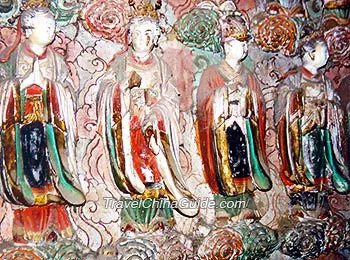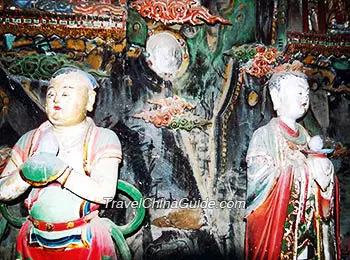Shuilu Temple
Famous for more than 3,700 delicately painted clay Buddhas culptures with a long history of more than 1,000 years, Shuilu Temple, or Shuilu’an Temple, is called “The Second Dunhuang in China”. Situated in Lantian County, about 60km (37 miles) to the southeast of Xi'an city, Shuilu Temple is a small courtyard at the foot of Wangshun Mountain.
First built in Sui Dynasty (518-619), Shuilu Temple used to be the Shuilu Hall of Wuzhen Temple, a grand temple complex, which was damaged over time. In 1563 of the Ming Dynasty (1368-1644), local seignior changed its name into Shuilu Temple and invited sculptors to make the most of the sculptures we can see today, while a few sculptures here were made in Tang Dynasty (618-907) and the Five Dynasties (907-960).
In the first hall of Shuilu Temple, a barefoot immortal stone statue of North Wei Dynasty (386-534) excavated from Bailuyuan was moved here to be exhibited.
All the clay sculptures are in Zhusheng Shuilu Hall behind the first hall. The hall was divided into 2 parts by a wall. On the front part of the wall are sculptures of three Buddhas, Sakyamuni in the middle, Amitabha on the left and Bhaisajya Guru on the right, all with a height of 5.63m (18.47 ft). These three Buddhas all have exquisite back screens behind them and two retinues on each side.Beside the Sakyamuni are Ananda and Kasyapa, and the retinues beside the other two Buddhas are a Confucian and a Taoist figure. The co-existence of Buddhas with Confucian and Taoist figures clearly shows the secularization of Buddhism in Ming Dynasty.
On the back of this wall, there are three sculptures of Three Great Beings, Avalokitesvara sitting on a stage in middle, Samantabhadra riding a white elephant and Manjushri on a lion on the sides. These three Buddhas wear tall crowns and have moustaches which can also be seen on other Buddha sculptures here. This kind of androgynous Buddha figures that have characteristic of both sexualities is very rare in China.
On the opposite of the Three Great Beings, a group of sculptures showing “Thousand Buddhas listening to Sakyamuni talking about Dharma”, some of which are made by famous Tang sculptor Yang Huizhi. Among the crowd you can see some of them are figures in Confucianism and Taoism, which shows the fusion of Buddhism, Confucianism and Taoism in China.
What’s most impressive are the clay sculptures on the north and south side walls telling the story of Sakyamuni’s whole life. There are also sculptures of rivers, gardens, pavilions, pagodas,
hundreds of Buddhas, thousands of believers and various animals, demonstrating vivid imagination and superb skills of the sculptors.
On the walls beside the door is Sambhogakaya on the north and Dharmakaya on the south. Three clouds above the Dharmakaya carrying Confucious, Sakyamuni and Laotze, the representatives of Confucianism, Buddhism, and Taoism, is another sign of the fusion of the three religions.
First built in Sui Dynasty (518-619), Shuilu Temple used to be the Shuilu Hall of Wuzhen Temple, a grand temple complex, which was damaged over time. In 1563 of the Ming Dynasty (1368-1644), local seignior changed its name into Shuilu Temple and invited sculptors to make the most of the sculptures we can see today, while a few sculptures here were made in Tang Dynasty (618-907) and the Five Dynasties (907-960).
|
|
In the first hall of Shuilu Temple, a barefoot immortal stone statue of North Wei Dynasty (386-534) excavated from Bailuyuan was moved here to be exhibited.
All the clay sculptures are in Zhusheng Shuilu Hall behind the first hall. The hall was divided into 2 parts by a wall. On the front part of the wall are sculptures of three Buddhas, Sakyamuni in the middle, Amitabha on the left and Bhaisajya Guru on the right, all with a height of 5.63m (18.47 ft). These three Buddhas all have exquisite back screens behind them and two retinues on each side.Beside the Sakyamuni are Ananda and Kasyapa, and the retinues beside the other two Buddhas are a Confucian and a Taoist figure. The co-existence of Buddhas with Confucian and Taoist figures clearly shows the secularization of Buddhism in Ming Dynasty.
On the back of this wall, there are three sculptures of Three Great Beings, Avalokitesvara sitting on a stage in middle, Samantabhadra riding a white elephant and Manjushri on a lion on the sides. These three Buddhas wear tall crowns and have moustaches which can also be seen on other Buddha sculptures here. This kind of androgynous Buddha figures that have characteristic of both sexualities is very rare in China.
On the opposite of the Three Great Beings, a group of sculptures showing “Thousand Buddhas listening to Sakyamuni talking about Dharma”, some of which are made by famous Tang sculptor Yang Huizhi. Among the crowd you can see some of them are figures in Confucianism and Taoism, which shows the fusion of Buddhism, Confucianism and Taoism in China.
What’s most impressive are the clay sculptures on the north and south side walls telling the story of Sakyamuni’s whole life. There are also sculptures of rivers, gardens, pavilions, pagodas,
hundreds of Buddhas, thousands of believers and various animals, demonstrating vivid imagination and superb skills of the sculptors.
On the walls beside the door is Sambhogakaya on the north and Dharmakaya on the south. Three clouds above the Dharmakaya carrying Confucious, Sakyamuni and Laotze, the representatives of Confucianism, Buddhism, and Taoism, is another sign of the fusion of the three religions.
Tips
1. You are not allowed to take photos inside the hall. But brochures with photos of the clay sculptures are on sale.
2. From January 22th to 25th in Chinese lunar calendar there is a temple fair in Shuilu Temple. Lots of people would come here to burn incense and make their new year wish. It is rather crowded then.
3. The entry ticket includes the Wuzhen Temple built in 2000 opposite the Shuilu Temple. You could hang around in it if you have time. Inside the temple there is the second largest clay reclining Buddha in the world.
2. From January 22th to 25th in Chinese lunar calendar there is a temple fair in Shuilu Temple. Lots of people would come here to burn incense and make their new year wish. It is rather crowded then.
3. The entry ticket includes the Wuzhen Temple built in 2000 opposite the Shuilu Temple. You could hang around in it if you have time. Inside the temple there is the second largest clay reclining Buddha in the world.
How to get to Shuilu Temple
You can take bus 926 at Xi'an City Stadium Station and get off at Lantian Bus Station. Then take the express bus in the station to Shuilu Temple.
Xi'an Bus / Metro Search
Xi'an Bus / Metro Search
| Admission Fee | Free. But you need to get the ticket by the valid ID certification like a passport. |
| Opening Hours | 9:00-17:00, closed on Mondays |
- Last updated on Aug. 01, 2025 by Alex Jin -

